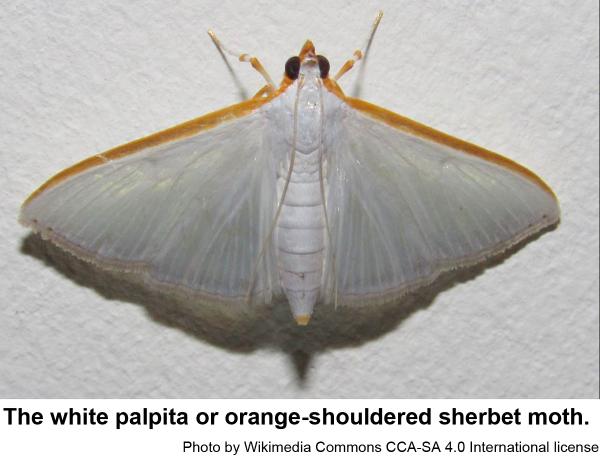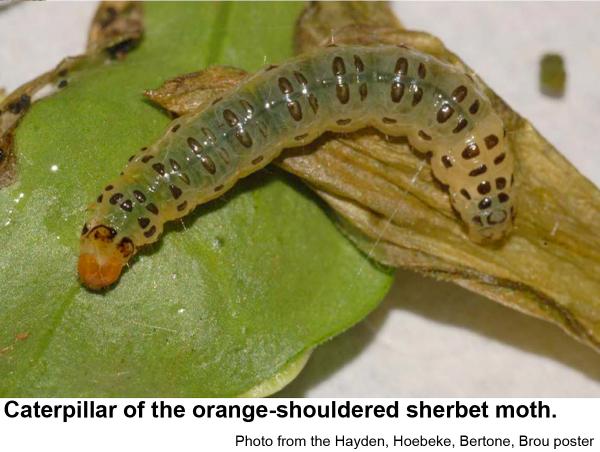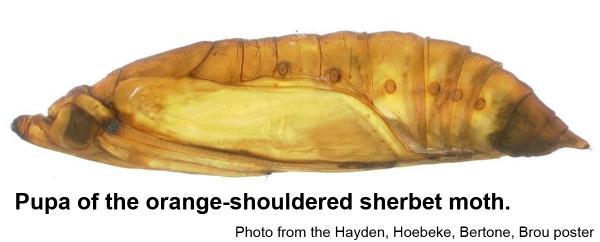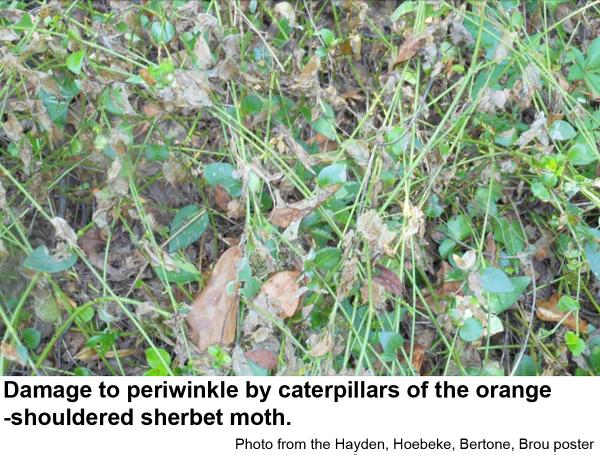Description and Biology
Phalaena costata (Diaphania costata) is known as the orange-shouldered sherbet moth or white palpita moth (which is confusing as this moth is not in the genus Palpita). Orange-shouldered sherbet moth caterpillars are spotted, translucent greenish, and have orange-brown heads. They grow to about 1 inch long as they fold host plant leaves with a sort of messy web in which they take shelter, grow, and eventually pupate. Pupae are slender, brown, and about 1/2 inch long. From pupae inside the “nest” emerge lovely white moths with a gold band on the outer margin of the forewings. The snout and legs are also marked with orange to gold. They fly from late July through mid October. We probably have two generations per year in North Carolina.
Host Plants
Orange-shouldered sherbet caterpillars web up and feed on plants in the dogbane family including confederate jasmine, eastern bluestar, and periwinkle or vinca. The caterpillars may ruin ruin the appearance of vinca and other hosts.
Residential Recommendations
Although orange-shouldered sherbet moths are rarely reported in North Carolina, sometimes even rare insects can be locally abundant. Should chemical control be desired, one of the pyrethroids readily available in most garden centers should work well. When used as directed, pyrethroids are very toxic to insects but are not particularly hazardous to humans and pets (other than fish—avoid using pyrethroids around pools, ponds, and streams).
Other Resources
- Diaphania costata (Diaphania costata). Staff Writer. 2018. Insect Identification for the Casual Observer.
- “Diaphania” costata (F.), a misidentified pest of Apocynaceae in the Southeastern United States. {Poster} Hayden, J. E., E. R. Hoebeke, M. A. Bertone, and V. A. Brou. 2017.
- Diaphania costata (F.) (Lepidoptera: Crambidae: Spilomelinae), a Commonly Misidentified Pest of Ornamental Apocynaceae in the Southern United States. Hayden, J. E., E. R. Hoebeke, M. A. Bertone, and V. A. Brou. 2017. Proceedings of the Entomological Society of Washington, 119(2):173-191.
- Species Diaphania costata - Hodges#5216. Quinn, M. 2017. BugGuide. Iowa State University.
- NC State Extension Plant Pathology Publications
- NC State Horticultural Science Publications
- North Carolina Agricultural Chemicals Manual
For assistance with a specific problem, contact your local N.C. Cooperative Extension center.
This factsheet has not been peer reviewed.
Publication date: Jan. 18, 2019
Reviewed/Revised: Nov. 4, 2023
Recommendations for the use of agricultural chemicals are included in this publication as a convenience to the reader. The use of brand names and any mention or listing of commercial products or services in this publication does not imply endorsement by NC State University or N.C. A&T State University nor discrimination against similar products or services not mentioned. Individuals who use agricultural chemicals are responsible for ensuring that the intended use complies with current regulations and conforms to the product label. Be sure to obtain current information about usage regulations and examine a current product label before applying any chemical. For assistance, contact your local N.C. Cooperative Extension county center.
N.C. Cooperative Extension prohibits discrimination and harassment regardless of age, color, disability, family and marital status, gender identity, national origin, political beliefs, race, religion, sex (including pregnancy), sexual orientation and veteran status.




